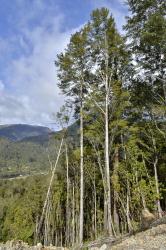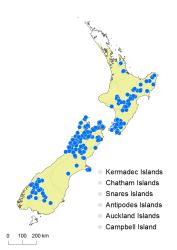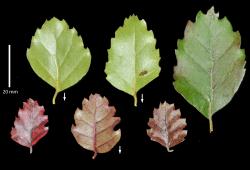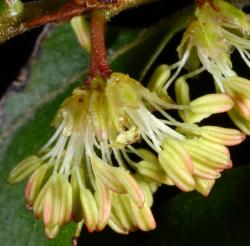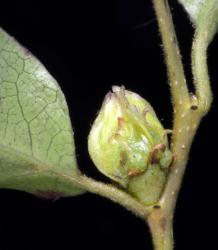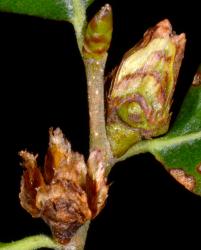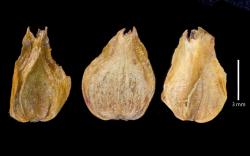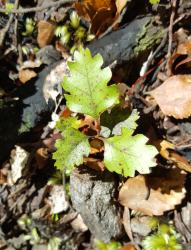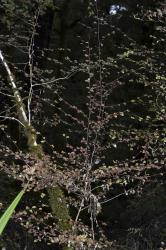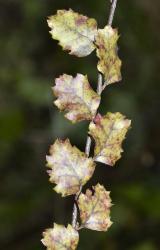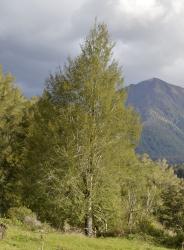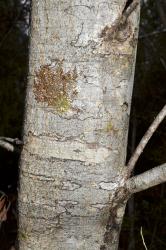- Taxon
- Gallery
- ≡ Fagus fusca Hook.f., Icon. Pl. 7, t. 630 – 631 (1844)
- ≡ Nothofagus fusca (Hook.f.) Oerst., Kongel. Danske Vidensk. Selsk. Skr., Naturvidensk. Math. Afd. 9: 355 (1871)
Large tree (15–)24–30(–40) m high; trunk straight and cylindrical, 1.5–2.0(–3.0) m in diameter, usually with heavy basal flanges and root buttresses; crown massive and spreading. Young branchlets terete, grooved, red-brown to dark red, with whitish pubescence. Stipules caducous, peltate, basally bilobed or entire, 4.0–11.0 mm long, oblong to narrow oblanceolate. Leaf lamina, 12–45(–55) × 7.0–35(–40) mm, broadly ovate, broad elliptic-ovate, rhomboid-ovate to sub-orbicular, thin coriaceous, veins distinct, often with 1 or 2 fringed domatia in basal axils; adaxially glossy green, often reddish, glabrescent; abaxially lighter green to red, glabrescent; margin coarsely serrate, teeth twisted and apiculate, shortly ciliate in sinuses; apex obtuse to acute; base oblique; petiole 2–8 mm long, pubescent. Staminate inflorescences, 3–5/branchlet, on peduncles 2.0–6.5 mm long; 1–3 flowers/dichasium, sessile or on short pedicels to 1.5 mm long; perianth campanulate, 4.0–6.2 mm long, glabrous or hairy, stramineous often tinged red or pink, with 3–5 prominent obtuse to acute lobes, margin glabrous. Stamens 6–20; filaments 3.0–6.0 mm long, glabrous; anthers 3.5–5.0 mm long, glabrous, yellow or red. Pistillate inflorescences, 1–3/branchlet, sessile or subsessile; dichasium, ovoid to globose, with (2)–3 sessile flowers/cupule, flowers trimerous and dimerous, sparsely hairy. Mature cupule woody, 5–8 mm long; valves 4, broadly ovate to triangular, coriaceous, resinous, strigulose, apex acute to attenuate; lamellae 2 or 3/valve, acute to attenuate. Nut 5.5–8 × 3.5–6.5 mm, triquetrous or lenticular, sparsely hairy to pubescent, winged, red-brown to brown.
Bark and wood: Bark on young trees smooth, thin and grey-white to light brown; bark on old trees thick, fibrous, large-scaled and furrowed, brown to dark-brown. Sapwood pink or red to light yellow when fresh; heartwood dark red when fresh.
Juvenile leaves: Often smaller than adult leaves, broad ovate to rhomboid-ovate, lamina thinner and more coarsely toothed, often red or red speckled.
Most similar to Fuscospora truncata, and distinguished from that species by thin leaves with apiculate lamina teeth that are noticeably twisted and also with the lamina tapering obliquely to the base, whereas hard beech has blunt lamina teeth that are not distinctly twisted and with the lamina tapering equally to the base. Also, red beech commonly has 1 or 2 fringed domatia in the axils of the midrib and lower secondary veins on the abaxial side of the lamina; domatia are absent in F. truncata and all other southern beech species in New Zealand except for Lophozonia menziesii.
North Island: South Auckland (Kaimai Range south of Te Aroha, Mamaku Range, Raukūmara Range, Urewera National Park, Hauhungaroa Range, Kaimanawa Range, Kaweka Range), Volcanic Plateau, Wellington (Tararua, Rimutaka and Aorangi Ranges).
South Island: Nelson, Marlborough, Westland, Canterbury, Otago (inland Lakes District), Southland, Fiordland.
Altitudinal range, sea-level–1190 m a.s.l. (at Potae, Ruahine Range). Lowland to montane forest. Found in pure stands in inland valleys on colluvial soils of mid-slope between 400 and 850 m. Also, commonly in association in mixed broadleaf-conifer forests and with other beech species on slopes and river terraces, and particularly with Lophozonia menziesii.
Flowering: Sep.–Dec. (mast seeding)



